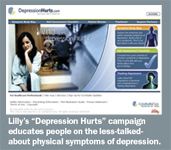Direct to Consumer: Q&A with Jill Balderson
We need to do more than just distribute information-we need to look at how consumers process, internalize, and act on that information. Health education is a process that is very personal and complex.
Dtc ads often don't teach consumers how to tackle their health issues. They may disseminate information, but they don't tell consumers how to act on that information. Jill Balderson, vice president of strategic marketing services at HealthEd, says consumers deserve more education and less promotion from pharma marketers. "Sometimes the most valuable and useful information—such as how to use the product—gets muddled in a promotional message," she says. "Education means giving patients information they need to know in order to see a positive outcome." She says that traditional patient materials lack the clarity and specificity that consumers need to learn about a disease or illness, let alone follow the medication's directions. But, Balderson believes times are changing. "Marketers are starting to realize that consumers need information they can not only understand but use," she says.

Jill Balderson
Balderson talks to Pharm Exec about the value of educational marketing in improving patient compliance. She gives insight into how to craft effective educational materials that speak to patients with different learning styles.
Pharm Exec: How do you define educational marketing? And how does this approach differ from traditional DTC strategies?
Balderson: I definitely see a shift from a heavy-handed branded approach to a more informational approach. But I don't think information is the same as education. Health education is a process that is very personal and complex. We need to do more than just distribute information—we need to look at how consumers process, internalize, and act on information. Educational marketing should deliver information, instead of promotional messages, free trials, offers, and premiums. At its best, educational marketing takes into account all of these challenges. It helps teach rather than tell. And it's the responsible thing to do.

Lilly's "Depression Hurts" campaign educates people on the less-talked-about physical symptoms of depression.
What is the value of educational marketing for consumers?
Many people have certain barriers to action. That barrier could be seeking treatment for a condition, accepting a diagnosis, or making the informed decision to take that therapy and stay on it. Some people don't have the skills to talk about their symptoms with doctors or to integrate the task of taking a pill into their everyday life. Some people may just not believe in using drugs to treat a condition. In a lot of ways, people tend to think that by not acting, they are putting themselves at less risk. A successful educational program effectively helps patients overcome these barriers.
What role should healthcare professionals play in disseminating disease information?
Nowadays, healthcare professionals are seeing more patients, but spending less time with each of them. So, they generally welcome marketing materials that can effectively educate. They promote materials that allow their patients to accurately interpret and understand their symptoms and encourage them to track those symptoms over time. This way doctors know which medications work and which don't. While some doctors' offices have a no-branded-materials policy, we find that by increasing the utility of the materials, we can help break down the no-branded mentality.
How can marketers improve educational materials?
Consumers tend to be very literal. Therefore, materials must clearly spell out the side effects of a medication and the repercussions for not taking it properly. Because of space issues, this can be challenging. In fact, many materials ignore the need for specificity. For example, the materials for a pediatric GERD [gastro-esophageal reflux disease] drug recommend that users elevate the bed for children. When you ask people if this information is useful to them, they often say, "How on earth do you elevate the bed? Should I raise it five feet off the ground? Do I put a pillow under it?" They don't know what "elevate the bed" means. It's important to teach people, rather than just tell them, what they're supposed to do.
The materials for a certain Alzheimer's drug also confuse patients. The materials recommend that patients take the drug with meals. The questions we hear are: "What is a meal? Some people have soup for dinner—does that count as a meal?" In order to avoid this confusion, we work with our patients to understand their concerns. Once we have developed a draft of material, we will often go back to patients and ask them: Does this help answer your questions?
Health education takes many forms. How do consumers respond to the different mediums?
People have different learning styles. Visual learners like to see illustrations while others prefer audio-visual materials that they might find on a DVD or Web site. Others are more receptive to hearing someone tell them what to do. Those people may benefit from a phone-based program where health experts field questions from patients through teleconferencing. Some people prefer a more hands-on approach and learn by doing. These people can benefit from live seminars, health fairs, or workshops.
Each channel has its own role and place in the marketing mix. Television is a fantastic reach vehicle but there's only so much education it can deliver in a standard-length TV spot. Print and online also have limitations in terms of space. Ultimately, an integrated approach that comprises several different formats reinforces the message most powerfully.
What campaign can the industry use as a model?
Lilly's "Depression Hurts" campaign has a powerful, educational message. Unlike other campaigns for anti-depressants, it calls attention to the physical symptoms of depression and intimates that depression hurts other people in one's life. Most importantly, the print ads drive people to seek more information at depressionhurts.com or to call an 800 number to receive more materials. The Web site offers a very interactive symptom body map that reinforces the educational message that depression causes physical pain. It also allows visitors to determine if they have symptoms of depression.
Launches The California Family Health Council debuted three 30-second broadcast spots to increase awareness about emergency contraception. / The American Heart Association introduced a public policy campaign encouraging volunteers to advocate increased funding for heart disease.

Stacey Singer
People Ableson-Taylor promoted three staffers: Shanika Bradley became account supervisor, Rachel Callahan became account director, and Nicholas Avallone became clinical research associate. / Stacey Singer was promoted to managing partner at CommonHealth. / Ignite Health reorganized its corporate structure. Jackie Herr was selected as CEO; Tim Riley was named chief marketing officer; Rich Fair was named chief creative officer; and Fabio Gratton became chief innovation officer.

The Misinformation Maze: Navigating Public Health in the Digital Age
March 11th 2025Jennifer Butler, chief commercial officer of Pleio, discusses misinformation's threat to public health, where patients are turning for trustworthy health information, the industry's pivot to peer-to-patient strategies to educate patients, and more.
Navigating Distrust: Pharma in the Age of Social Media
February 18th 2025Ian Baer, Founder and CEO of Sooth, discusses how the growing distrust in social media will impact industry marketing strategies and the relationships between pharmaceutical companies and the patients they aim to serve. He also explains dark social, how to combat misinformation, closing the trust gap, and more.